Abstract
Studies were conducted on the survival of Vibrio vulnificus, an estuarine human pathogen, in oyster homogenates held at 4 degrees C. Results indicated a rapid and dramatic decrease in viability not attributable to either cold shock or the oyster homogenate alone but to a combination of the two. Such a decline was not observed with Vibrio parahaemolyticus. Chilled V. vulnificus cells were unable to repair themselves in brain heart infusion broth at 37 degrees C. V. vulnificus cells incubated on whole raw oysters at 0.5 degrees C also exhibited a decline in viability, but of a lesser degree. The effects of various plating media were also investigated. The data reported here suggest that oysters kept on ice are not likely to be a major factor in the epidemiology of V. vulnificus infection. It is further suggested that the standard method of homogenizing oysters for examining bacteriological quality should not be followed because toxic compounds are released from the oysters during this process.
Full text
PDF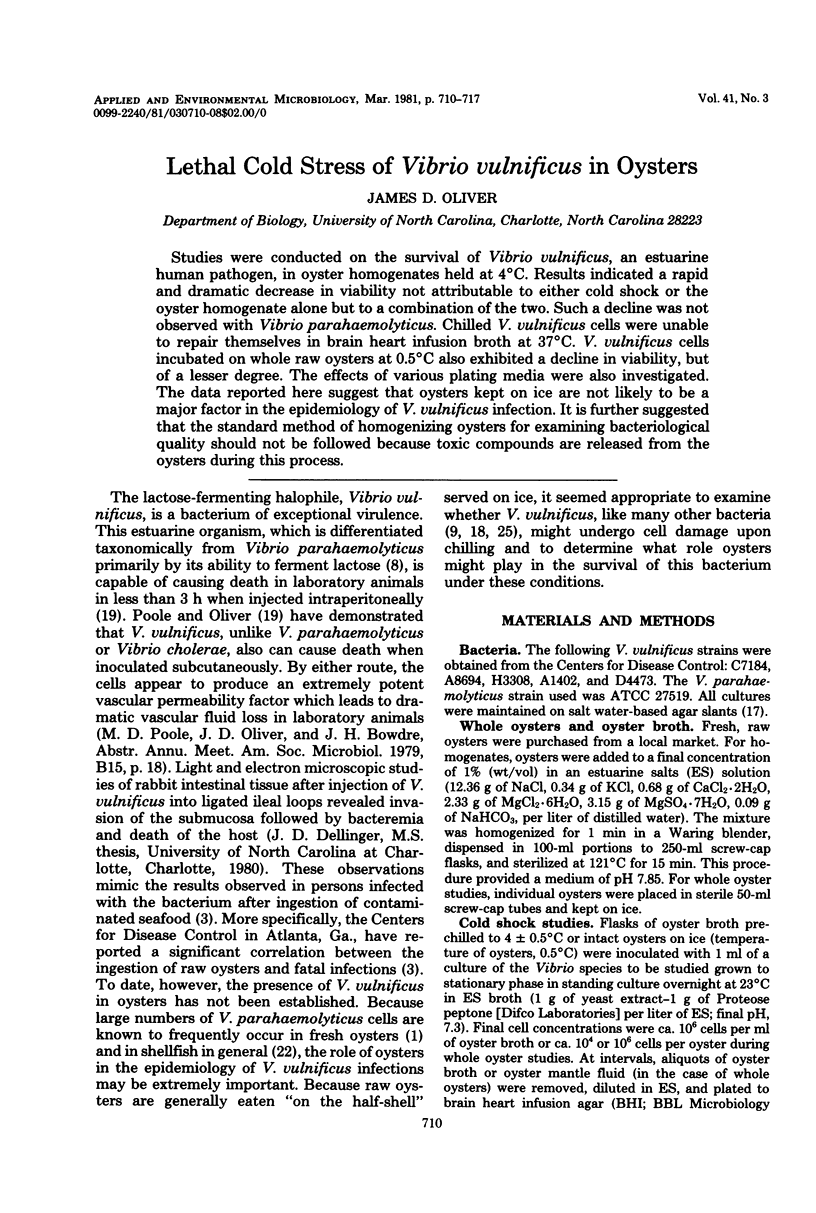
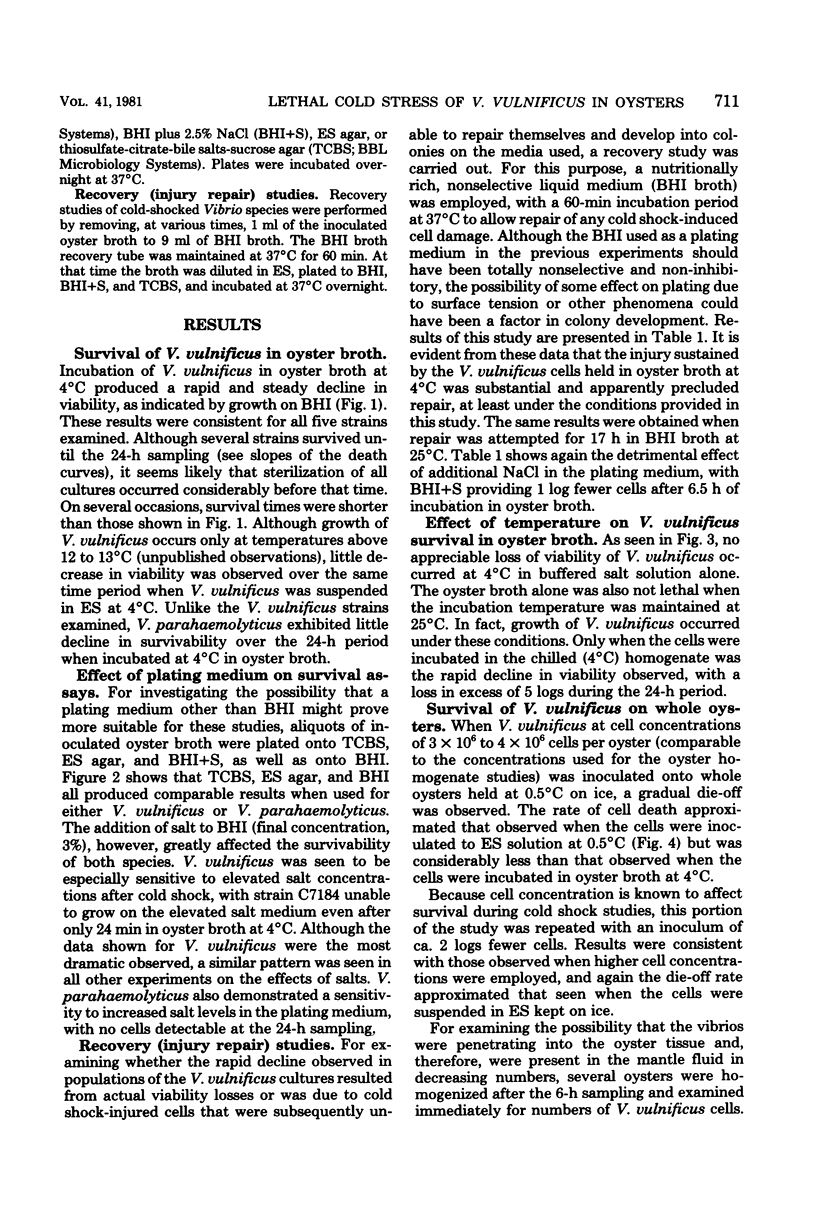
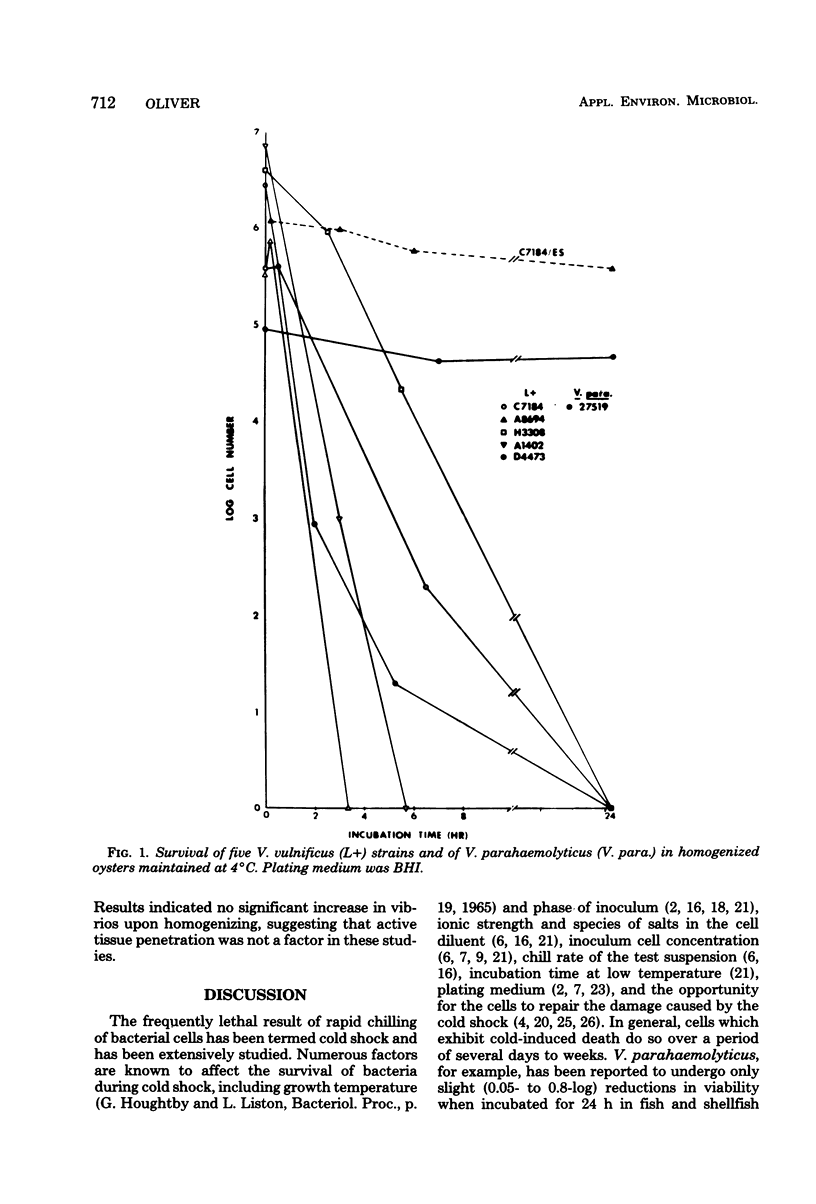
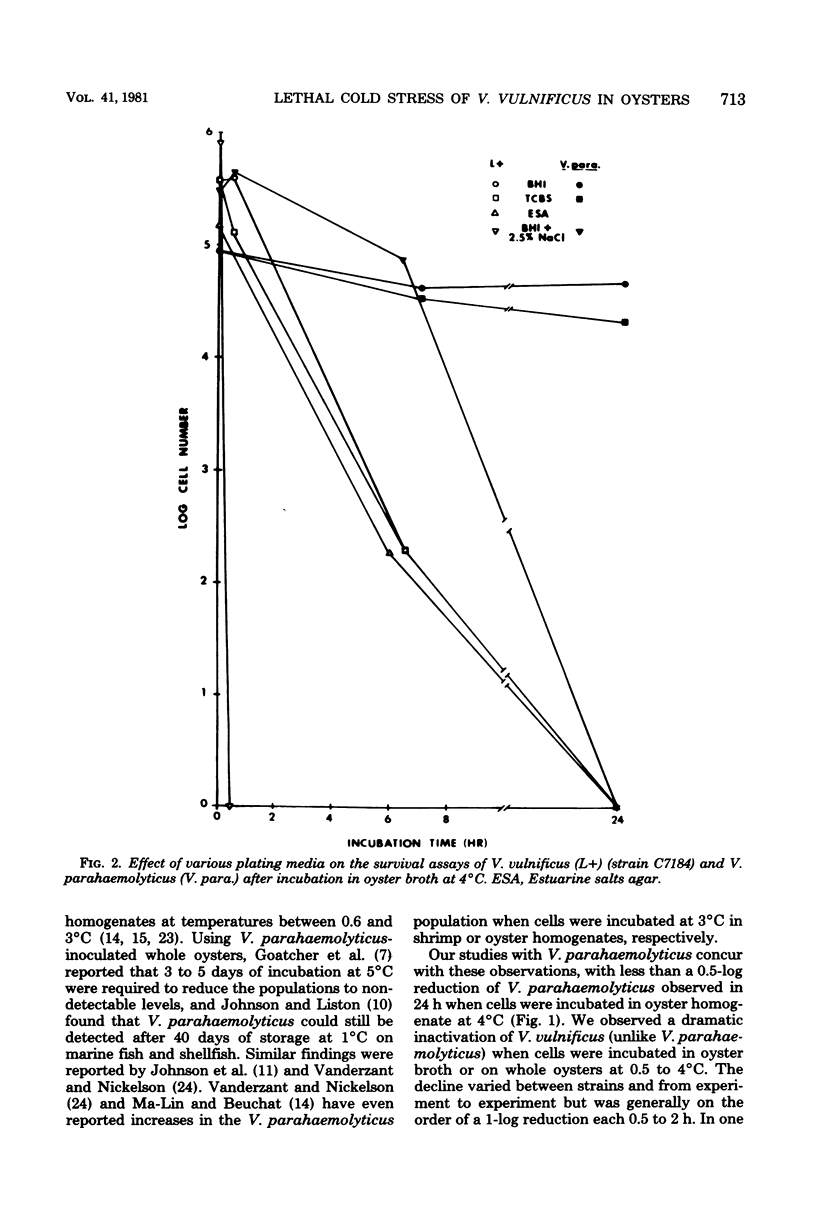
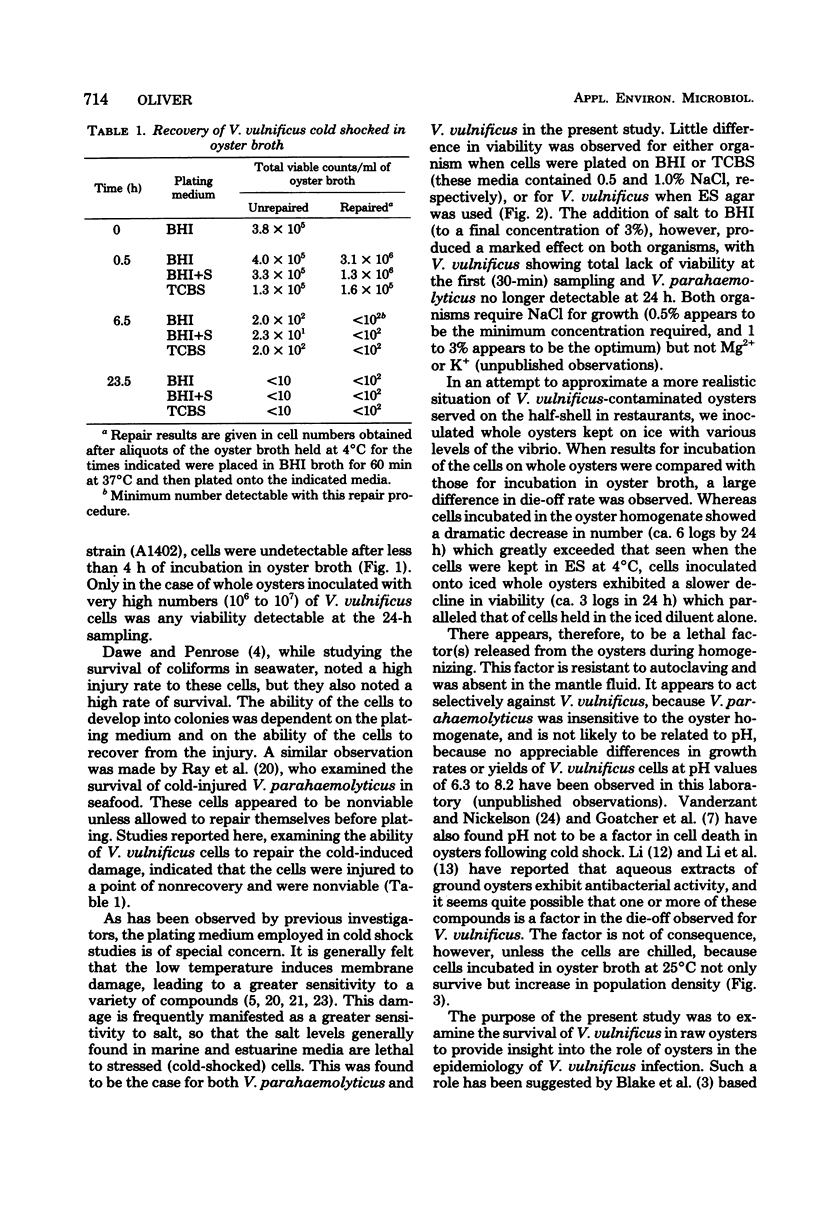
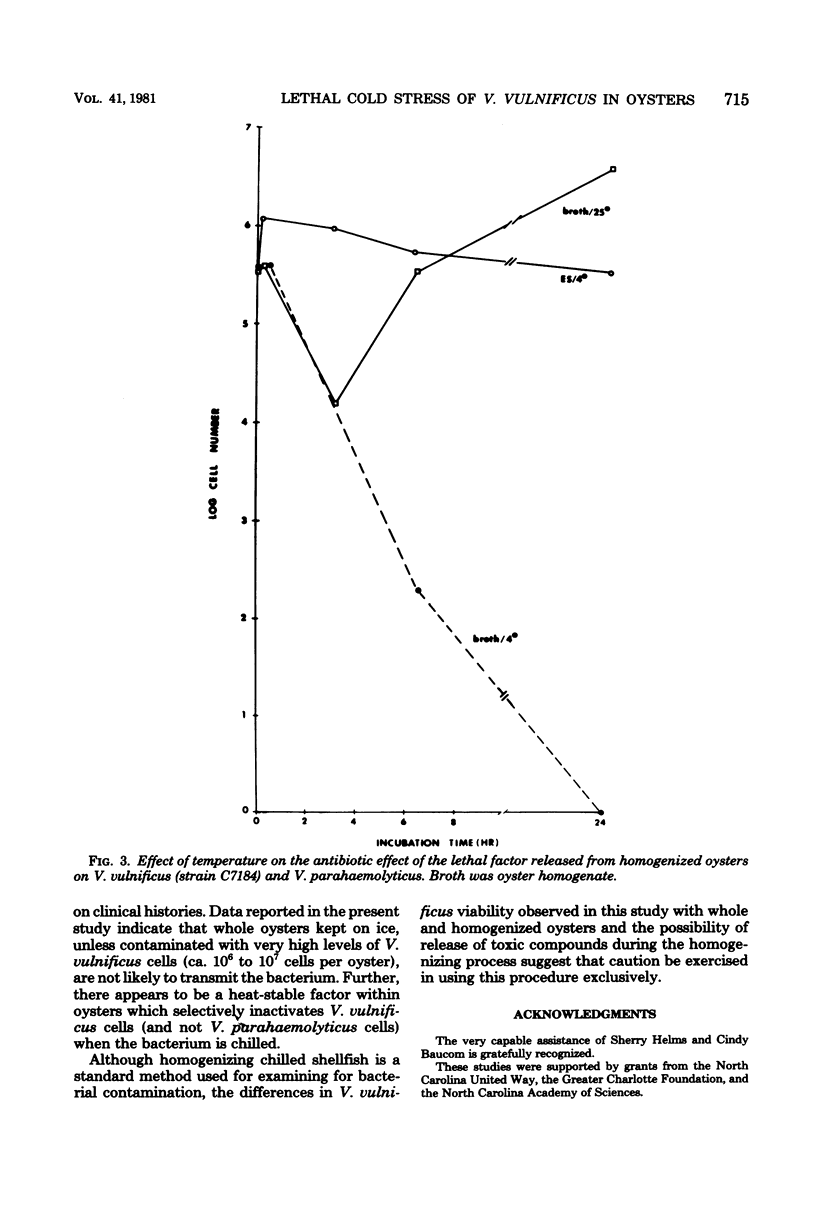
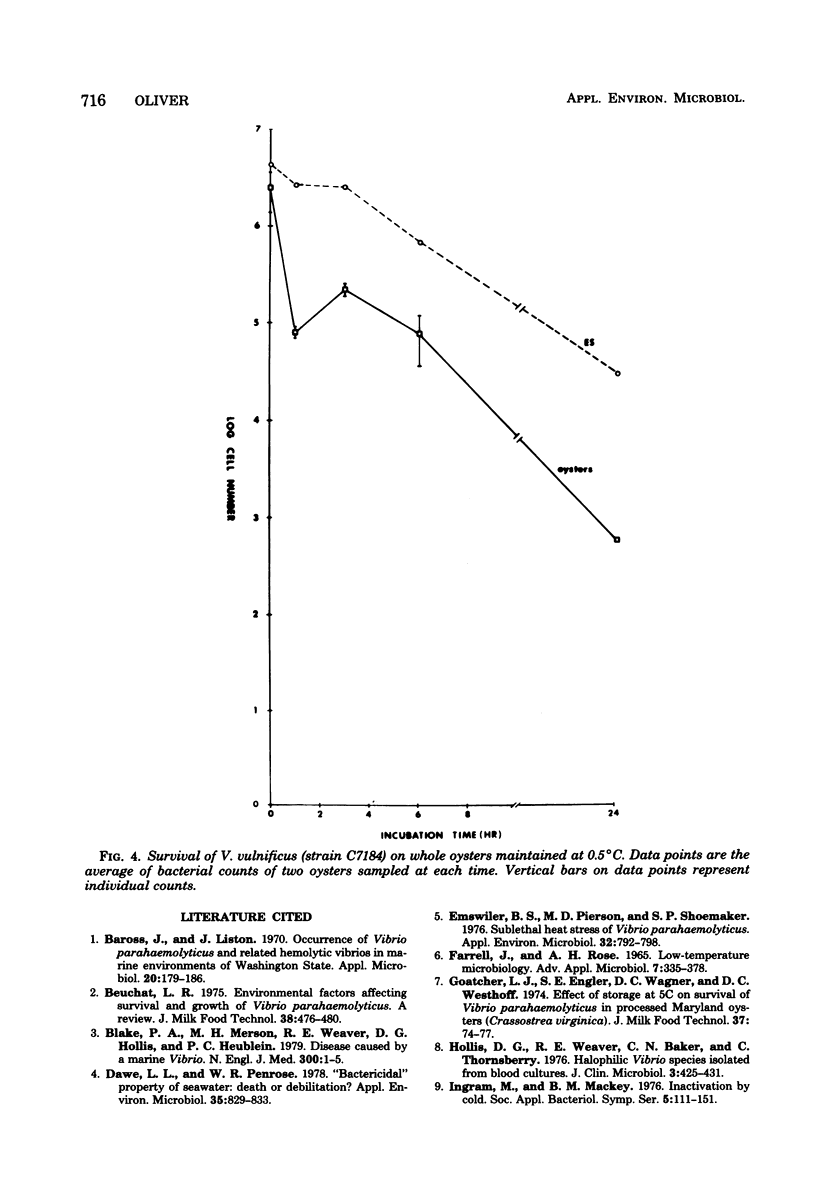
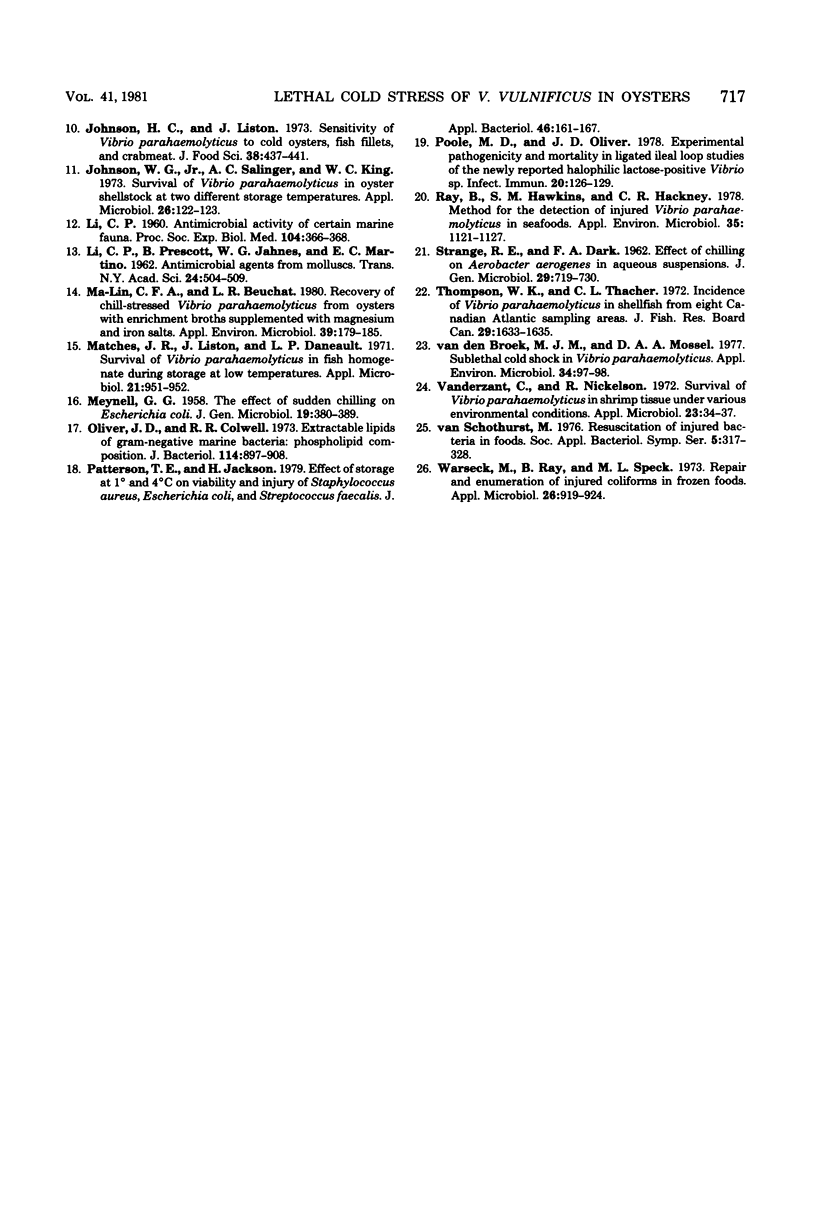
Selected References
These references are in PubMed. This may not be the complete list of references from this article.
- Baross J., Liston J. Occurrence of Vibrio parahaemolyticus and related hemolytic vibrios in marine environments of Washington State. Appl Microbiol. 1970 Aug;20(2):179–186. doi: 10.1128/am.20.2.179-186.1970. [DOI] [PMC free article] [PubMed] [Google Scholar]
- Blake P. A., Merson M. H., Weaver R. E., Hollis D. G., Heublein P. C. Disease caused by a marine Vibrio. Clinical characteristics and epidemiology. N Engl J Med. 1979 Jan 4;300(1):1–5. doi: 10.1056/NEJM197901043000101. [DOI] [PubMed] [Google Scholar]
- Dawe L. L., Penrose W. R. "Bactericidal" property of seawater: death or debilitation? Appl Environ Microbiol. 1978 May;35(5):829–833. doi: 10.1128/aem.35.5.829-833.1978. [DOI] [PMC free article] [PubMed] [Google Scholar]
- Emswiler B. S., Pierson M. D., Shoemaker S. P. Sublethal heat stress of Vibrio parahaemolyticus. Appl Environ Microbiol. 1976 Dec;32(6):792–798. doi: 10.1128/aem.32.6.792-798.1976. [DOI] [PMC free article] [PubMed] [Google Scholar]
- Farrell J., Rose A. H. Low-temperature microbiology. Adv Appl Microbiol. 1965;7:335–378. doi: 10.1016/s0065-2164(08)70391-5. [DOI] [PubMed] [Google Scholar]
- Hollis D. G., Weaver R. E., Baker C. N., Thornsberry C. Halophilic Vibrio species isolated from blood cultures. J Clin Microbiol. 1976 Apr;3(4):425–431. doi: 10.1128/jcm.3.4.425-431.1976. [DOI] [PMC free article] [PubMed] [Google Scholar]
- Johnson W. G., Jr, Salinger A. C., King W. C. Survival of Vibrio parahaemolyticus in oyster shellstock at two different storage temperatures. Appl Microbiol. 1973 Jul;26(1):122–123. doi: 10.1128/am.26.1.122-123.1973. [DOI] [PMC free article] [PubMed] [Google Scholar]
- LI C. P. Antimicrobial activity of certain marine fauna. Proc Soc Exp Biol Med. 1960 Jul;104:366–368. doi: 10.3181/00379727-104-25839. [DOI] [PubMed] [Google Scholar]
- LI C. P., PRESCOTT B., JAHNES W. G., MARTINO E. C. Antimicrobial agents from mollusks. Trans N Y Acad Sci. 1962 Mar;24:504–509. doi: 10.1111/j.2164-0947.1962.tb01427.x. [DOI] [PubMed] [Google Scholar]
- MEYNELL G. G. The effect of sudden chilling on Escherichia coli. J Gen Microbiol. 1958 Oct;19(2):380–389. doi: 10.1099/00221287-19-2-380. [DOI] [PubMed] [Google Scholar]
- Ma-Lin C. F., Beuchat L. R. Recovery of chill-stressed Vibrio parahaemolyticus from oysters with enrichment broths supplemented with magnesium and iron salts. Appl Environ Microbiol. 1980 Jan;39(1):179–185. doi: 10.1128/aem.39.1.179-185.1980. [DOI] [PMC free article] [PubMed] [Google Scholar]
- Matches J. R., Liston J., Daneault L. P. Survival of Vibrio parahaemolyticus in fish homogenate during storage at low temperatures. Appl Microbiol. 1971 May;21(5):951–952. doi: 10.1128/am.21.5.951-952.1971. [DOI] [PMC free article] [PubMed] [Google Scholar]
- Oliver J. D., Colwell R. R. Extractable lipids of gram-negative marine bacteria: phospholipid composition. J Bacteriol. 1973 Jun;114(3):897–908. doi: 10.1128/jb.114.3.897-908.1973. [DOI] [PMC free article] [PubMed] [Google Scholar]
- Patterson T. E., Jackson H. Effect of storage at 1 degree and 4 degrees C on viability and injury of Staphylococcus aureus, Escherichia coli and Streptococcus faecalis. J Appl Bacteriol. 1979 Feb;46(1):161–167. doi: 10.1111/j.1365-2672.1979.tb02594.x. [DOI] [PubMed] [Google Scholar]
- Poole M. D., Oliver J. D. Experimental pathogenicity and mortality in ligated ileal loop studies of the newly reported halophilic lactose-positive Vibrio sp. Infect Immun. 1978 Apr;20(1):126–129. doi: 10.1128/iai.20.1.126-129.1978. [DOI] [PMC free article] [PubMed] [Google Scholar]
- Ray B., Hawkins S. M., Hackney C. R. Method for the detection of injured Vibrio parahaemolyticus in seafoods. Appl Environ Microbiol. 1978 Jun;35(6):1121–1127. doi: 10.1128/aem.35.6.1121-1127.1978. [DOI] [PMC free article] [PubMed] [Google Scholar]
- STRANGE R. E., DARK F. A. Effect of chilling on Aerobacter aerogenes in aqueous suspension. J Gen Microbiol. 1962 Dec;29:719–730. doi: 10.1099/00221287-29-4-719. [DOI] [PubMed] [Google Scholar]
- Vanderzant C., Nickelson R. Survival of Vibrio parahaemolyticus in shrimp tissue under various environmental conditions. Appl Microbiol. 1972 Jan;23(1):34–37. doi: 10.1128/am.23.1.34-37.1972. [DOI] [PMC free article] [PubMed] [Google Scholar]
- Warseck M., Ray B., Speck M. L. Repair and enumeration of injured coliforms in frozen foods. Appl Microbiol. 1973 Dec;26(6):919–924. doi: 10.1128/am.26.6.919-924.1973. [DOI] [PMC free article] [PubMed] [Google Scholar]
- van den Broek M. J., Mossel D. A. Sublethal cold shock in Vibrio parahaemolyticus. Appl Environ Microbiol. 1977 Jul;34(1):97–98. doi: 10.1128/aem.34.1.97-98.1977. [DOI] [PMC free article] [PubMed] [Google Scholar]


